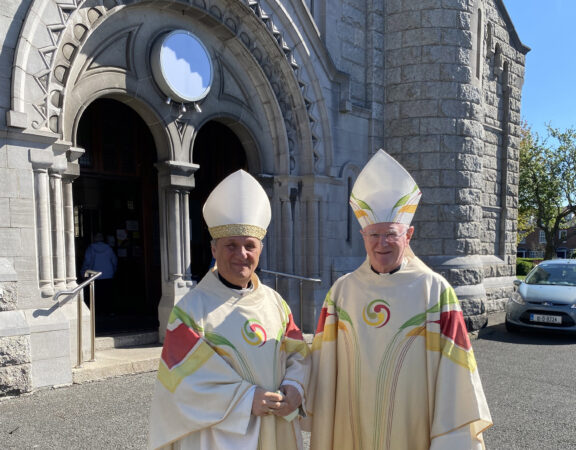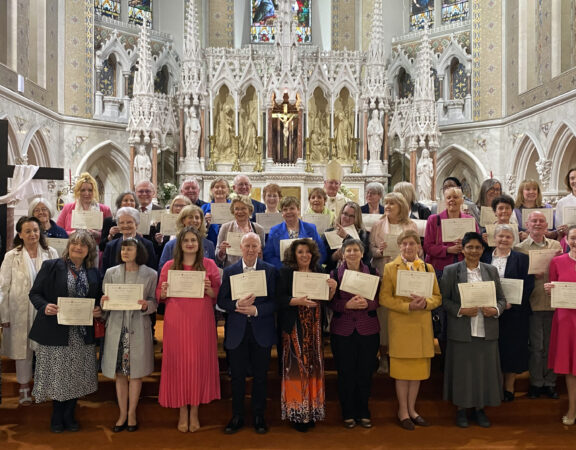Icon of Mary, Mother of Perpetual Help
SIXTH SUNDAY OF EASTER 2016
Homily notes of
Most Rev. Diarmuid Martin
Archbishop of Dublin
Pro-Cathedral, 30th April 2016
“The readings of today’s Mass, especially the first reading from the Acts of the Apostles and the Gospel reading from Saint John, show that the tone of the liturgy is already moving slowly from reflection on the Resurrection to prepare us for the Feast of Pentecost and the coming of the Spirit.
The readings also give us some idea of the early development of the Church and the manner in which the early Christian community was beginning to cope with the reality that Jesus was no longer with them and trying to grasp how the promised Holy Spirit would guide the Church in what were already changing and at times difficult situations.
The reading from the Acts of the Apostles shows that there was already division in the Church, between those who adhered to strict Jewish traditions and who felt that anyone coming to the Church had to take on the practices of the Jewish community. Those who, as the Church spread to different cultures, came from a pagan background could not understand this rigidity.
Communities were divided and we learn how the Apostles and the leaders of the Church came to a discernment, which was then communicated. Those who came from pagan origins would not be saddled with any burdens beyond what was essential in the teaching of Jesus. The Christian faith is not a faith of unnecessary burdens.
In the Gospel reading, words pronounced by Jesus earlier, are taken up to remind the diverse communities which had grown up at the time the Gospels were compiled, of what was of the essence of the Christian message. The old and false thought that the Messiah would impose the kingdom by rule of force was not the way of Jesus, even though many of his disciples had hoped even until the end that this would somehow take place.
Jesus brought a new rule and a new understanding of the kingdom. His kingdom would be a rule of love and where love is found then God will be found dwelling there. The Christian faith is not a faith of unnecessary burdens and human rules. Without love rules will be empty and alienating.
Twenty one centuries later, the tensions that we see in the early Church are still to be found today. There are those who are fearful and wish for a world in which rules as regards the Christian life should be set out and rules applied and rules obeyed.
That is of course correct, but the problem is that very often when we look more closely at those who would wish to see rules applied, they are often talking about their own rules, rather than the saving message of Jesus Christ.
There are those who fail to see how the Holy Spirit is still at work in the Church helping us to come to know the truth of Jesus Christ more fully. In today’s Gospel, Saint John reminds us that some within the early Church community were saddened and puzzled at the physical departure of Jesus from them and failed to see how the Holy Spirit continues right up until our days to strengthen, comfort and guide the Church and to lead us more fully into the truth.
The Christian life is a life where we humbly seek to know God and to live his path. Jesus’ message is never one which abandons people in their failure. It is always one which reaches out to draw people to conversion.
When I say that I have to pinch myself and remind myself that this is not a question of Jesus reaching out to others and calling them to conversion: he is reaching out to me to call me to conversion. All of us are sinners; all of us need to respond to the call of conversion. To think otherwise is to fall into arrogance. We are all sinners. Jesus teaches about sin; however Jesus does not wish us to fall into a climate of fear and negativity. His mercy is always there to reach out to us when we fail.
One of the problems is that we live in a world where we so often judge things and indeed people in black and white. We would like simple yes or no answers on subjects which are much more complex than we wish to admit. In this Jubilee Year of Mercy Pope Francis wants all of us to reflect on God’s mercy. Pope Francis does not set out to change the teaching of Jesus Christ or to say that in life’s choices anything goes; yet he constantly reaches out to those who find that teaching hard to realise in their own lives.
Where can we find a starting point in understanding Pope Francis position? I find a starting point in the first interview which Pope Francis gave shortly after his election, when he was asked by the interviewer: “who exactly is Jorge Mario Bergoglio”. The Pope’s instant answer was: “I am a sinner”. Then he paused and said: “Let me reflect on that”. “No”, he said, “that is correct, I am a sinner”.
This is the key to understanding many of Pope’s Francis’s phrases. A Pope who considers himself in the first place a sinner will never be arrogant and harsh in his judgement of other sinners. Even more important, a sinner who has experienced God’s mercy in the face of his own sinfulness will appreciate how that mercy – and not condemnation – is the path which can help others to reach the fullness of God’s teaching. Pope Francis, in another text, has said that the Christian life is not “a never falling down”, but “an always getting up again, thanks to [the hand of God] which catches us”.
This evening we welcome at our Mass the miraculous icon of Our Lady of Perpetual Help. What is an icon? Icons are not photographs. They are not attempts by an artist to portray his or her personal ideas of how Jesus or the Blessed Virgin or a Saint may possibly have looked like. They are more like an impressionist portrait than a photograph: their task is to make us think and ponder and reflect and lead us through contemplation ever more deeply into the mystery of God.
An icon is a work of art which speaks to the heart and evokes prayerful reflection. An icon is never something just put into a frame forever; it is an attempt to draw us every day anew into something deeper, rather than define a static flash-photographic image. An icon is an attempt to draw us into the Mystery of a God who wishes to be close to us in all things and especially at those times when we are in distress or anxiety or troubled by a sense of helplessness. It is an image which enables us to realise that in every moment of distress, God is there with his compassion and care.
It is not that this icon this evening is just an icon of Mary. Mary is herself the icon. She is the one who pondered and contemplated the many things about her son’s life and mission and learned day by day, in her own sorrow, to remain faithful to her son. She remained with her son and remained faithful to him even as she was pained by what was happening to him. At the Wedding Feast of Cana, she told the servants to do as her son commanded, even when she herself did not fully understand how her son would act. Her faith is a model of our faith. Her tender care for her son is the guarantee of her care for us. He pondering God’s word shows us the path which leads us to her son and to an understanding of our faith.
Our readings remind us of how the early Church came to realise more fully how the Christian faith is not a faith of unnecessary burdens and human rules. Our Lady of Perpetual Help is a perennial reminder of how our God is a God who always remains faithful to his people, a God who is always close to his people but, strangely for our logic, is especially close to those who fail and to those who are not faithful to him. Her Perpetual Help is our hope.
We pray for the constant help of Mary, Mother of Perpetual Help, for ourselves, for those who are dear to us, for those in our world who feel lost and abandoned and for our Church that it will become in society ever more a true icon of God’s mercy.”









